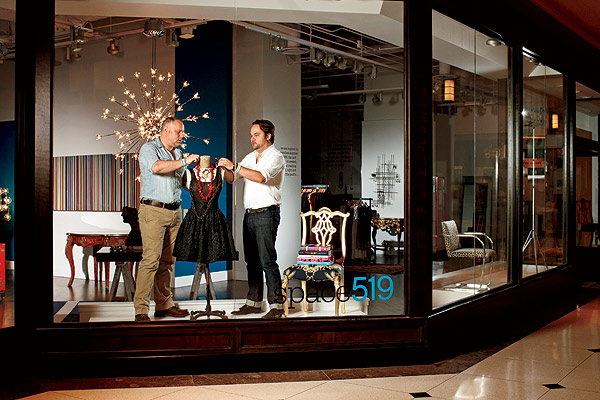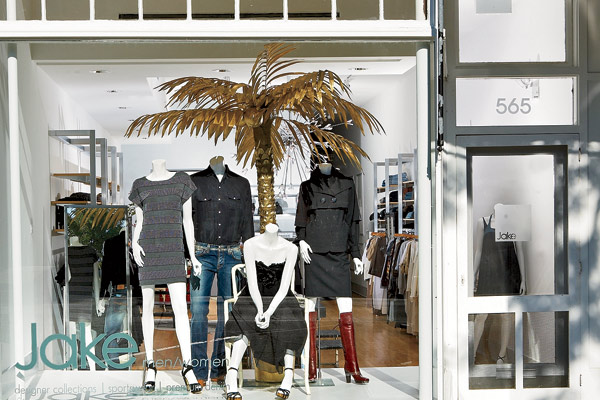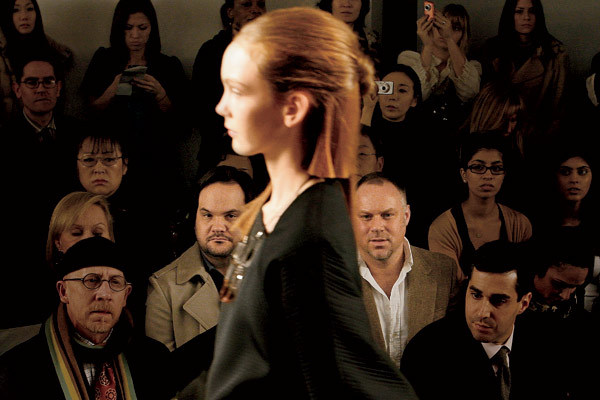
Jim Wetzel (left) and Lance Lawson behind the glass of their new venture, space519, at 900 North Michigan Avenue
Taking the stage two years ago in a ballroom of the Peninsula Chicago, Jim Wetzel and Lance Lawson certainly looked the part of ground-breaking fashion retailers. Wetzel wore a Band of Outsiders windowpane blazer and a Martin Margiela shirt, and Lawson sported a Tim Hamilton scarf. The proud owners of the Jake boutiques, they were there to be honored as pacesetters by the Fashion Group International of Chicago. In four years, Wetzel and Lawson had turned Jake into one of the most fashion-forward operations in the city, courting and selling up-and-coming American designers, such as Phillip Lim and Doo-Ri Chung, and earning front-row seats at the New York shows. The partners—in business and in life—had made a national name for themselves and in the process defied conventional wisdom about Midwestern fashion sense.
Acknowledging the crowd of industry insiders gathered that June evening, the two thanked their employees, the city, and their customers—whose taste, they declared, was foolishly underestimated. “No one recognized the savvy that was here,” Lawson said. It should have been a triumphant moment in their rocketing careers. But secretly they were fighting back dread. As Wetzel got dressed that night, he had to remind himself, “You deserve this,” he recalls. Lawson remembers, “We’re going to be celebrated for being these visionaries. I was sick to my stomach.”
Unknown to all but the two partners, the three-store Jake empire was floundering. A few hours earlier, Wetzel and Lawson had learned that a potentially rescuing investment deal had fallen through. “We pulled it together,” Lawson says about the awards dinner and impromptu postparty celebration with employees at Le Colonial. The couple forced themselves to think, Let’s relish tonight. Tomorrow’s another day.
A year later, the secret was out. A New York Times story detailed unpaid bills and a string of designers furious with “the hot young retailer of the Midwest.” Still, Wetzel and Lawson used their reputation, charm, and will to keep the business afloat until they filed for bankruptcy last March, in the process accumulating unpaid bills with yet more up-and-coming designers. “In the end, they just flipped a switch,” says the Chicago designer Agga Raya, creator of the line Agga B. “They kind of showed their true colors.”
After the bankruptcy filing, Jake shuttered its operations within weeks. A retinue of designers remains unpaid and bitter, several feeling betrayed by men they thought were friends. Though Wetzel, 41, and Lawson, 39, have opened a new project, “a refined general store,” as they put it, called space519 at 900 North Michigan Avenue, that venture amounts to an abrupt reinvention for a partnership that once promised to take Chicago fashion in a new direction.
“It’s very unfortunate what happened to Jake,” says Melissa Gamble, Chicago’s former director of fashion, arts, and events, who left the post at the end of June. Not only were local designers damaged, but the city’s reputation took a hit as well. “It has the potential effect of negating all the good things that are happening here.”
* * *
Photograph: Nathan Kirkman

The Winnetka boutique opened in 2007.
With its cowhide rug, large church lantern hanging from the ceiling, and sleek, sexy fashions from designers few knew, the original Jake boutique immediately sought its own niche. Opening on Southport Avenue in 2004 and offering both women’s and men’s clothing, Jake set itself apart from other local boutiques that were either “überexpensive,” such as Ikram or Blake, or too girly, Lawson says. “We bought for the store as if it were in New York or Los Angeles,” he adds. “When we went to [trade] shows they told us this was too edgy for Chicago. They expected us to be conventional, but we weren’t.”
Jake represented the natural culmination of Jim Wetzel’s extensive retail career. Growing up in Skokie, he cut class at Niles North High School to work at the women’s retail chain T. Edwards at Old Orchard shopping center. “I couldn’t get enough of it,” Wetzel says. “I would blow off classes if they needed me. I would merchandise windows. I would clean the bathroom. I would steam clothes. I would do anything they asked me. I was addicted to retail.” He went on to help open 50 Gap stores and serve as Midwest regional merchandising manager for J.Crew, designer manager at Henri Bendel, and a store director at Gucci in Chicago, among other positions.
Lance Lawson, meanwhile, grew up in Denver with dreams of becoming an actor. He eventually earned a law degree but built a career in marketing and sales. He and Wetzel met through a mutual friend, and as their romance grew, Lawson wanted in on Wetzel’s plan to open a store. He quit as director of sales and marketing at Starz Encore Group, the cable movie and entertainment provider, two weeks after Jake opened.
They made a dynamic partnership. Lawson ran the business side, aggressively tapping his marketing background, and Wetzel, responsible for the creative end, furnished the retail savvy. It didn’t take long for local media and shoppers to respond. When Daily Candy, an e-mail newsletter that likes to hunt cool things, wrote about Jake, the store received dozens of calls and visits from new customers. When a profile appeared in the Chicago Tribune Sunday magazine, eager shoppers lined up outside the Southport Avenue store. In June 2004, The New York Times cited Jake in the opening paragraphs of a story about Chicago’s emerging fashion presence, mentioning its signature wall hanging, a large aerial photograph of Chicago that shoppers often mistook for New York.
The partners ran the store like a cocktail party. Chatty and clever, they forged friendships with shoppers, many of whom became loyal patrons. “They made every customer feel like their best friend,” recalls one former employee, who didn’t want her name used because she continues to work in retail. “They knew how to make people feel special.”
Amanda Puck, a public relations executive for The Experiential Agency, a marketing firm, became one of the couple’s best friends. “It was love at first sight,” she says of the owners and their store. “I loved both their energies and their sense of style.” Of her purchases at Jake, Puck still wears a studded black dress by Isabel Marant, brown leather platforms by Barbara Bui, and a leather-trimmed tube top and navy tulip skirt from Doo.Ri. “I had never heard of Doo.Ri,” Puck says.
Introducing new lines to Chicago became Jake’s niche. The partners carried Phillip Lim’s first collection, selling every piece. They sold customers on Doo-Ri Chung’s flattering trademark draping, at one point moving $50,000 worth of her clothing in a day. They brought in the New York design company Lutz & Patmos for a designer appearance and became one of the top sellers of the pricey cashmere sweater line, second only to Barneys New York.
Wetzel had a gift for finding the right pieces for his customers. “He always nailed it,” says Puck, who was hired to do publicity for the Gold Coast store and now does the marketing for the 900 Shops, which includes the partners’ new venture. “I said I wanted a pair of black jeans. He pulled one pair in my size and it fit perfectly. They knew their clients inside and out.”
As partners, Wetzel and Lawson complement each other. Wetzel tilts optimistic, possessing an almost childlike enthusiasm for stuff he likes, be it a lip balm, a candle, or a piece of clothing. Lawson is more grounded, edgier, and possesses a sharp wit. “They’ve got a good cop, bad cop thing going,” Puck says.
The combo worked, and the men say they cleared $1 million in Jake’s first year. As sales and their reputation grew, they took a bold and expensive step in 2005, signing a five-year lease for space on Rush Street in the Gold Coast. Doors down from Ikram and Barneys New York, Jake now put itself in a sink-or-swim scenario with some of Chicago’s major fashion players.
* * *
Photograph: Andreas E. G. Larsson

Lawson (center left) and Wetzel (center right) enjoy prominent seats at the Doo.Ri show in New York in 2008.
At its peak, Jake’s Gold Coast store pulled in almost $4 million in sales annually. Top clients spent $75,000 to $100,000 per year, Lawson says. Jessica Simpson stopped by a couple of times, buying a Tucker floral peasant blouse, a Richard Chai top, jeans, and shoes. Kanye West shopped there, piquing the interest of Us Weekly.
The partners, meanwhile, hosted champagne luncheons, private teas, and lavish holiday parties. Wetzel drove a BMW convertible and wore a Breitling watch on buying trips. Some store directors earned six figures. A story in Entrepreneur magazine pegged the duo as “Young Millionaires” and projected Jake’s 2007 sales at $7 million. That year, a new Jake opened in Winnetka, and the brand’s website hit the $1 million mark in revenue.
As the designers they championed rose through the ranks, so did Lawson and Wetzel. At New York Fashion Week, Doo-Ri Chung put them in the front row at her show in seats generally reserved for top editors and big-dollar buyers from Barneys New York, Bloomingdale’s or Saks Fifth Avenue. Jake had become one of Chung’s top accounts. Afterward, Women’s Wear Daily ran Lawson’s opinions alongside feedback from industry veterans.
Jake’s success dovetailed with Mayor Richard Daley’s effort to support the local fashion business. Daley formed the Mayor’s Fashion Council, appointed Melissa Gamble the director of fashion, arts, and events, and sponsored Chicago’s own fashion week. Wetzel and Lawson used their new stature to help local designers, too. In Jake’s early days, the Southport boutique carried figure-hugging dresses from Orlando Espinoza and chunky necklaces made of semiprecious stones from Susanne Siegel. Later, the store sold thousands of dollars in merchandise from local fashion lines DieterBennet, Agga B., and 5p1t, now known as the Kirk James Collection.
Lawson and Wetzel sat on the board of the Chicago Fashion Incubator, a program providing support and mentoring for promising Chicago talent. The retailers regularly visited the fledgling designers, giving feedback and offering business tips on sourcing and distribution. “They were always coming in and checking what we were working on,” recalls Agga Raya, an early participant in the incubator program.
* * *
Photography: Chicago Tribune photo by Shiho Fukada

Fashion designers (from left) Doo-Ri Chung, Agga Raya, and Tina Lutz and Marsha Patmos complained of unpaid bills.
Jake’s first sign of trouble came in the spring of 2008, when sales slowed on Southport Avenue. “That was our barometer,” Lawson says. By then, Jake employed 24 people. With price points on the rise (dresses averaged $700, shoes $450, and jeans $250), Jake began to encroach on the prized luxury territory guarded by Ikram and Blake.
Then the landscape started to shift. The up-and-coming designers supported by Wetzel and Lawson now had their own egos, higher-priced clothes, and higher-profile businesses to run. Lawson says that some of them, such as Phillip Lim and Alexander Wang, had become so popular that they required retailers to place minimum orders of $20,000 per delivery. What’s more, some of the cult lines were no longer hard to find. The Bucktown boutique p.45, for example, was also an early proponent of Lim, whose 3.1 Phillip Lim line is now carried by Barneys New York, Neiman Marcus, and Nordstrom. Blake carried Chris Benz shirts similar to those at Jake, and Barneys New York announced plans in 2008 to double its size with a new store steps away from Jake.
When the business failed to meet profitability marks in the second quarter of 2008, its lender, MB Financial, wasted no time applying pressure. “They wanted to liquidate us,” Lawson says. “Late that summer, the bank started freaking out. They saw what was going to happen.” When the partners searched for new investors, some prospects followed up. “They looked at our story and the trajectory, and they were very interested,” Lawson says. “Then they looked at the balance sheet with all that debt.” About $1.5 million, he estimates.
MB Financial ordered Lawson and Wetzel to hire a consultant at High Ridge Partners to oversee spending. “Everything we paid had to be approved by her,” says Lawson. They were allowed to pay employees but not themselves. “The bank was managing our money.”
The stock market crashed in October, about the same time Jake closed its Southport store with a few months left on the lease. Overall, according to the owners, sales had decreased 35 to 40 percent that spring from the previous year, and that fall sales dropped 80 percent from the prior year. Demand for the new legion of American designers seemed to die out. “For Doo.Ri, we had built a huge following,” Lawson says, “but by 2009, if people were going to pay $600 or $700, they wanted name brands. The day of sampling American designers was over.”
The customers spending $75,000 a year stopped coming. “Our best clients all went into hiding,” Lawson recalls. One woman told him her husband threatened divorce if she didn’t curtail her shopping. Lawson and Wetzel had ordered inventory on credit, at times six months prior to delivery, based on the past year’s strong sales. When the clothing didn’t sell, they couldn’t pay their bills yet had to order more merchandise on credit to keep the stores fresh. “Our payables were so out of skew with our revenue,” Lawson says. “It was a mistake not to be operating with a larger line of credit.”
The New York designer Marcia Patmos, who estimates Jake owes Lutz & Patmos, her former company, about $57,000, didn’t initially suspect anything was wrong. “Many stores don’t pay on time,” she says, “but they [Wetzel and Lawson] always came through.” So when Jake still owed money on past season’s clothing, Patmos says her company sent part of the new collection because of that positive relationship. After much back and forth between Jake and her bookkeeper, Patmos received a check. It bounced. “They had every opportunity to tell us,” she says. “They kept promising everything would be okay.”
Wetzel and Lawson asked designers to hold tight while they handled credit issues with their bank. They spoke of an upcoming cash infusion. With the bank in control of finances and refusing to pay off debt, Lawson stopped taking phone calls and responding to e-mails. As the bank threatened foreclosure, Wetzel and Lawson worked a deal to avoid liquidation. They paid back a portion of the $1.6 million loan from MB Financial, and the bank acquired Jake’s assets—accounted at only $65,000. Wetzel and Lawson then arranged a new $240,000 loan from Belcorp Financial Services in Hinsdale, with their residence as primary collateral. Using that loan, the partners established a new entity—controlled by a trust, with Lawson’s father and Wetzel’s mother as administrators—and bought back the assets.
Though the deal kept Jake in business, many of the designers who had trusted the partners remained unpaid and, of course, were irate. “We considered them friends—they were so sweet,” Doo-Ri Chung told The New York Times. She estimated that Jake owed her $60,000.
Patmos rallied 28 designers, including Phillip Lim, Erin Fetherston, and Loeffler Randall, to hire Dan Zazove, a Chicago attorney with Perkins Coie. Zazove says that some of the smaller designers—a few of them operating out of their homes or lofts—weren’t able to fully bounce back. “I got the feeling at first they [Lawson and Wetzel] weren’t that remorseful,” he adds. (Lawson points out that he and Zazove never spoke in person.)
On behalf of his clients, Zazove filed an involuntary bankruptcy petition seeking $516,000 in unpaid bills from Jake. The hope was to reclaim any money made through the new venture or to find any mishandling of funds from the first.
Lawson acknowledges that some of the aggrieved designers thought the sale of assets amounted to sleight of hand. “All the records were reviewed,” he says. “Everything was under such tight scrutiny we couldn’t have taken any money if we tried.”
With the company held in trust, Jake unveiled a new business plan in February 2009. Out were the higher-priced new stars, and in were lower-priced up-and-comers, including three of Chicago’s most promising: the now defunct DieterBennet, Agga B., and 5p1t. Given Jake’s history, Agga Raya, of Agga B., knew she was taking a risk. “They said, ‘Hey, bring in your product. It looks great. Bring more and bring more.’ My friends asked me, ‘Are you sure this is the right partnership for you?’ I knew I was gambling.” Still, Raya says, “I wanted to be on Rush Street.” Plus, she knew Wetzel and Lawson from the Chicago Fashion Incubator. “We operated on a very friendly level,” Raya says. In retrospect, she adds, that “meant it was unprofessional.”
For much of 2009, the relationship proved fruitful, with Jake selling $4,000 to $6,000 of her clothes each month. Urged to create a stronger holiday presence for December, Raya poured herself and her savings into producing gold-flecked wool dresses with leather trim. “I spent all my money to deliver before the holiday,” she says. Afterward, Raya tried to collect her money, around $14,000. In return, Lawson sent her “horrible e-mails, rude and discourteous,” she says. (Lawson claims she was e-mailing him several times a day and regularly coming by the store. “After a while, it becomes maddening,” he says.)
Jake filed for bankruptcy in March 2010. According to court records, assets were estimated at less than $50,000, debts from $500,000 to $1 million, and more than 30 designers were still owed money. “The impact on so many designers was devastating,” says Melissa Gamble. “They feel like they have another mountain to climb.” Daryl Sneed of 5p1t, now called Kirk James Collection, says the Chicago-based company is still trying to regroup from its $19,000 loss to Jake. “Everyone had mutual anger toward those two guys," says Sneed, whose checks from Jake bounced. “That’s a significant chunk of revenue to us—but you have to move on.”
Today, Jake’s old location on Rush Street is a Gap 1969 denim store. The Southport space sells synthetic grass, and the Winnetka boutique, which closed in October 2009, remains vacant.
Zazove questions whether Lawson and Wetzel undervalued Jake’s assets prior to selling the company. “What happened to all the money?” he asks. The trustee appointed to examine the case found no assets in July. Wetzel and Lawson “left a big trail of debt,” Zazove says.
* * *
Photography: (From left) AP Photo/Stuart Ramson, Keith Claunch, Andy Marlin/AM Photography/Getty Images
When the partners talk about the demise of Jake, Lawson’s emotions flare, and he remains largely unapologetic. “I’m sad that people take this so personally and wish us ill will,” he says. “We feel horrible for the people who were injured by the store. We ended up injured, too.” But it pains both men to be blamed by some designers whose businesses Jake helped build. “We carried some designers for many seasons before they were profitable,” Lawson says. “You learn how quickly everyone turns on you.”
He continues, “We made mistakes, but there was no maliciousness. We morphed into these monsters overnight. People were so angry about the recession. . . . They needed a poster child. We were the lambs put out to slaughter.” Lawson says the guilt from the entire experience sent him to a therapist. “You have no idea the courage it took to keep the business open in the last 18 months.”
Still, both Lawson and Wetzel say the collapse made their relationship stronger. When one was down, the other rallied. And in the darkest times, they needed only to look out the window of their home in Ravenswood Manor to know things could be worse. They live kitty-cornered to the former Illinois governor Rod Blagojevich, whose house was constantly surrounded by CNN trucks. “It was crazy,” Wetzel says.
* * *
For many businesses, bankruptcy signals the end. That’s not necessarily true in the world of fashion, where some of the best-known names, Marc Jacobs and Tommy Hilfiger, for example, have weathered more than one failed venture. (“You’re not in business until you’ve gone bankrupt,” Hilfiger said when he was in Chicago recently, according to Lawson.)
After news of Jake’s bankruptcy broke in March, Wetzel and Lawson announced plans for their new project, space519. Lawson says that he and Wetzel, who are still personally responsible to both MB Financial and Belcorp for the earlier Jake loans, used what was left of their savings to open the new store. They estimate that space519 cost $30,000 to launch, roughly one-third of the capital used to launch Jake on Southport.
On opening day at space519 this past May, Lawson and Wetzel looked tired, although Wetzel drummed up enthusiasm for each piece he showed off. Inspired by the Parisian store Colette, the shop seemed a mishmash of things the partners liked or had discovered: candles, cosmetics, jewelry, jeans, books, and hard-to-find magazines, such as Monocle. Lawson even stocked his favorite enchilada sauce, which he found while visiting his family in New Mexico.
After several weeks, space519 makes more sense. Sadie’s Salsa is displayed along with Santa Fe Style coffee-table books, Native American jewelry, beaded salt and pepper shakers, black earthenware pottery, and that enchilada sauce. Traces of Jake’s earlier aesthetic surface in the $315 buttery soft hobo handbags from Collina Strada and the $95 studded cuffs from Hayden Harnett. Items range from $15 nail polish to $225 dresses to a $1,250 vintage dresser.
Sales the first two weeks of June topped those for all of May, says Lawson, and the partners tend the floor most every day. The young “fashiony guys” working at J.Crew are regulars. Any book about Paris sells out, and visitors still mistake that aerial shot of Chicago (now hanging behind space519’s cash register) for New York. Customers from the Southport days trickle in. “We don’t hold grudges,” Lawson says.
The partners recently turned out for a local fashion event where some designers chose not to talk to them. “It felt like Scarlett O’Hara going to Ashley Wilkes’s birthday party,” Wetzel jokes.
Both say they are relieved to be without the burden of Jake and the pressure of running an upscale operation in this economy, but they are happy to be back in the retailing game. “We thrive on being able to share our creative vision. We want to show we can do this,” Lawson says, adding that all of space519’s inventory is prepaid and the partners signed a one-year commitment at 900 North Michigan Avenue. “We wanted a redemption.”


